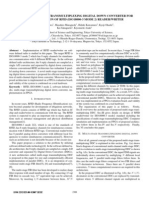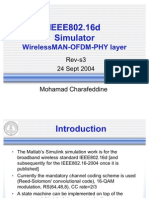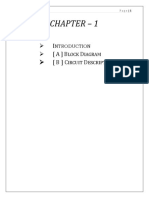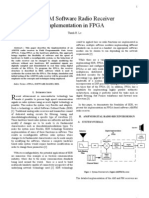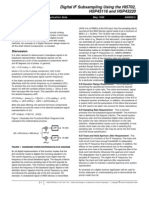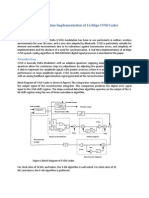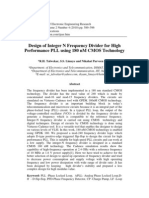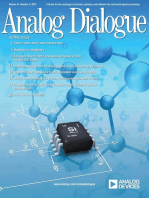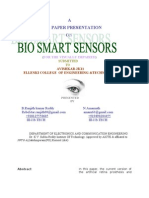OFDM Transceiver Design With FPGA and DEMO On DE2-70 Board: Content
OFDM Transceiver Design With FPGA and DEMO On DE2-70 Board: Content
Uploaded by
Amar NathCopyright:
Available Formats
OFDM Transceiver Design With FPGA and DEMO On DE2-70 Board: Content
OFDM Transceiver Design With FPGA and DEMO On DE2-70 Board: Content
Uploaded by
Amar NathOriginal Description:
Original Title
Copyright
Available Formats
Share this document
Did you find this document useful?
Is this content inappropriate?
Copyright:
Available Formats
OFDM Transceiver Design With FPGA and DEMO On DE2-70 Board: Content
OFDM Transceiver Design With FPGA and DEMO On DE2-70 Board: Content
Uploaded by
Amar NathCopyright:
Available Formats
OFDM transceiver design with FPGA and Demo on DE2-70 board By: Zhi Yong Li, NJIT
OFDM transceiver design with FPGA and DEMO on DE2-70 board
Advisor: Ali Akansu By: Zhi Yong Li Date: 9/7/2008
Content:
1. 2. Project of OFDM transceiver FPGA design of OFDM transceiver a, OFDM transceiver design b, OFDM demo program design c. Special notes for the Demo program
3, OFDM transceiver demo on DE2-70 board 4, Reference
Attachment: VHDL program
page 1 of total 40
OFDM transceiver design with FPGA and Demo on DE2-70 board By: Zhi Yong Li, NJIT
1.
Project of OFDM transceiver
Orthogonal frequency-division multiplexing (OFDM), is identical to Coded OFDM (COFDM) and Discrete multi-tone modulation (DMT), is a frequency-division multiplexing (FDM) scheme utilized as a digital multi-carrier modulation method. Many of closely-spaced orthogonal sub-carriers are used to carry data. The data are divided into several parallel data streams or channels, one for each sub-carrier. Each sub-carrier is modulated with a conventional modulation scheme (such as quadrature amplitude modulation or phase shift keying) at a low symbol rate, keeping the total data rates similar to conventional single-carrier modulation schemes in the same bandwidth. OFDM has developed into a popular scheme for wideband digital communication, whether wireless or over copper wires, used in applications such as digital television and audio broadcasting, wireless networking and broadband internet access. The primary advantage of OFDM over single-carrier schemes is its ability to cope with severe channel conditions , for example, attenuation of high frequencies in a long copper wire, narrowband interference and frequency-selective fading due to multipath, without complex equalization filters. Channel equalization is simplified because OFDM may be viewed as using many slowly-modulated narrowband signals rather than one rapidly-modulated wideband signal. The low symbol rate makes the use of a guard interval between symbols affordable, making it possible to handle time-spreading and eliminate intersymbol interference (ISI). This mechanism also facilitates the design of single-frequency networks, where several adjacent transmitters send the same signal simultaneously at the same frequency, as the signals from multiple distant transmitters may be combined constructively, rather than interfering as would typically occur in a traditional single-carrier system. In this project, The OFDM transeiver will be designed with VHDL language and implemented in Cyclone 2 FPGA device on DE2-70 board, which in cludes the OFDM transmitter(16 QAM modulator and length N IDFT) and receiver( length N DFT and 16 QAM demodulator). Transmitter An OFDM carrier signal is the sum of a number of orthogonal sub-carriers, with baseband data on each sub-carrier being independently modulated commonly using some type of quadrature amplitude modulation (QAM) in this project, This composite baseband signal is typically used to modulate a main RF carrier. Input signal of OFDM transmitter s[n] is a serial stream of binary digits. By inverse multiplexing, these are first demultiplexed into parallel streams, and each one
page 2 of total 40
OFDM transceiver design with FPGA and Demo on DE2-70 board By: Zhi Yong Li, NJIT
mapped to a complex symbol stream using 16-QAM modulation. An inverse FFT is computed on each set of symbols, delievering a set of complex symbols. These symbols are then quadrature-mixed to passband by the DAC components outside of FGPA device in the standard way. The real and imaginary components are first converted to the analogue domain using digital-to-analogue converters (DACs); the analogue signals are then used to modulate cosine and sine waves at the carrier frequency, fc, respectively. These signals are then summed to give the transmission signal, s(t).
Receiver In the receiver direction, antenner picks up the signal r(t), which is then quadrature-mixed down to baseband using cosine and sine waves at the carrier frequency. This also creates signals centered on 2fc, so low-pass filters are used to reject these. The baseband signals are then sampled and digitised using analogue-to-digital converters (ADCs) and then pass to the OFDM receiver in FPGA, inside the FPGA, a forward FFT is used to convert back to the frequency domain. This returns parallel streams, each of which is converted to a binary stream using an 16-QAM demodulator. These streams are then re-combined into a serial stream, , which is an estimate of the original binary stream at the transmitter
Goal of the project The goal of the project is to design the OFDM transmitter(16 QAM modulator and
page 3 of total 40
OFDM transceiver design with FPGA and Demo on DE2-70 board By: Zhi Yong Li, NJIT
length N IDFT) and receiver( length N DFT and 16 QAM demodulator) on Cyclone 2 device of DE2_70 board ultilizing the Quartus 2 FPGA developing tool and then demonstrate its function on DE2_70 board by utilizing the LCD and 7 segment display. In the demonstration, the input bit stream test vectors will be converted from the serial to parallel, pass to 16-QAM modulation, IFFT. Then these complex symbols will directly be converted from parallel to serial again and pass to OFDM receiver inside the FGPA. The receiver will convert the I, Q data back to the original binary data by going through the process of serail to paraller, FFT, 16-QAM demodulation, and parallel to serial conversion.
2. FPGA design of OFDM transceiver a, OFDM transceiver design The OFDM transceiver block diagram is as follows.
In our design implementation, due to the need of changeable length N of DFT, we will use the length N DFT and IDFT depicted another project paper ECE698 Length N DFT designs of OFDM for FPGA implementation instead of using real FFT and IFFT modules. OFDM transmitter will be activated when trans_chipen signal is high, the input bit stream Qam_in will be mapped to complex symbols every 4 bits in 16-qam
page 4 of total 40
OFDM transceiver design with FPGA and Demo on DE2-70 board By: Zhi Yong Li, NJIT
modulator which has the constellation map as follows.
The complex symbols amplitude of QAM output could be adjust by am generic constant of the VHDL program, in our program, the default value of am is set to 16, e.g., for 0101 input, the output of 16_QAM is (-1+j)*16. The default length of IFFT in our design is 16, the IFFT is actually the length N IDFT program, not the IFFT. It needs N clocks delays for the transforms. The Transmitter will send out the trans_oe as the enable signals to the next level component as well as the ifft_real_out and ifft_img_out for DAC which is real and imagine part of the IDFT results. OFDM receiver will be activated by the rec_chipen when it is high, the input of fft_img_in and fft_real_in is the imagine and real part of complex number from ADC, the receiver will pick up N=16 complex symbols every frame and converter to another batch of 16 complex symbols by length 16 DFT, then map them back to 4 bit binary signals in serial by 16-QAM demodulation. If we loop the transmitter output back to receiver input, we will get the original bit stream back. It is demonstrated in the function and timing simulation as follows. Also, it will be demonstrated on DE2-70 Demo board later. In the function simulation, bit stream input qam_in to transmitter is set 0 to 15 repeatedly, we will get the 0, -18-14j, 0, -1-8j, -8+24j, -5, 0, -3-2j, 0, -3+2j, 0, -5, 8+24j, -1+8j, 0, -14+18j 16 sets of complex symbols on ifft_real_out and ifft_img_out buses repeatedly after 18 clocks
page 5 of total 40
OFDM transceiver design with FPGA and Demo on DE2-70 board By: Zhi Yong Li, NJIT
delays. For the loop test, we need to set the fft_img_in and fft_real_in of receiver input signals to the same value of transmitter output, which you will see as follows in the vector wave form input files for the function simulation.
We are expecting the get 0 to 15 repeatedly from output of receiver, check the function simulation results as follows, the simulation is correct.
Before the timing simulation, we should check what the speed of our design is when it is implemented on Cyclone 2 devices, the timing analysis report as follows says the maximum register clock is 79.99MHZ, we will use iCLK_50=50MHZ for the timing
page 6 of total 40
OFDM transceiver design with FPGA and Demo on DE2-70 board By: Zhi Yong Li, NJIT
simulation and 25MHZ for the demo program on DE2-70 board later.
As we find out in the following timing simulation report, our design is correct in the simulation since we are getting back the original bit stream back on the output signal dqam_out of receiver which is from 0 to 15 while the output of transmitter is looped back to receiver.
Above all, all the simulation demonstrated that the design is correct. We will precede the demonstration on the real board in the next step.
page 7 of total 40
OFDM transceiver design with FPGA and Demo on DE2-70 board By: Zhi Yong Li, NJIT
Also, we could notice that when DFT and IDFT length is 16, we have used up 96 embedded multipliers out of 300 as follows; this means that 32 is our maximum length for transceiver if we still use embedded multiplier for transform calculation on this Cyclone part.
b, OFDM demo program design The Block diagram for the OFDM demo VHDL program is as follows.
page 8 of total 40
OFDM transceiver design with FPGA and Demo on DE2-70 board By: Zhi Yong Li, NJIT
Comparing with the transceiver, the size 256 ROM is added for input test vectors storage in the demo program. Also, 3 sets of size 256 RAM are added for IFFT, FFT, QAM demodulation results storage. In this way, we could display the results easily by utilizing the slow clock instead of 25MHZ on LCD and 7 segment display. As you could see from the diagram, iSW16 and iSW15 is used to select which RAM we want to check. When iSW16=0, iSW15=0, it is for IFFT results check. When iSW16=1, iSW15=0, it is for FFT results check. When iSW16=0, iSW15=1, it is for QAM demodulation results check, when both of them are 1, it is used for loop back.
c. Special notes for the Demo program The resource taking summary of this demo program is as follows.
From the OFDM transceiver report, we could see that the clock speed is around 79.99MHZ. In the actual design, 25MHZ for transceiver data processing clock is selected for the transceiver; this should be OK from the function point. Also, we will use length 16 DFT in our OFDM transceiver DEMO program; test vectors size will use 16 too to simplify the Demo process. More test vectors could be added by changing the vectno generic constant and the size of ROM in the ofdmdemo.vhd file.
3, OFDM transceiver demo on DE2-70 board
page 9 of total 40
OFDM transceiver design with FPGA and Demo on DE2-70 board By: Zhi Yong Li, NJIT
In the demonstration on DE2-70 board, first, we set the first 16 address content of qrom256.mif from 0 to 15 which is used as initialization file of ROM storing the 4 bit stream of QAM input. After compilation, download the demoofdm.sof or demoofdm.pof to the Cyclone 2 device. Then start the demo procedures as follows: First of all, Set SW16=1 and SW15=1(both in the up position) and then power it on, make sure that Led 14, 15, 16 light up.
Check the IFFT results:
1, Set SW16=0 and SW15=0(both in the low position) and then Press Key0, LEDR17 should light up and the LCD says IFFT RAM.. as follows .
page 10 of total 40
OFDM transceiver design with FPGA and Demo on DE2-70 board By: Zhi Yong Li, NJIT
2, Press Key2, LEDR17 should be off as follows,
3, Now it is ready to start the display of RAM contents.
page 11 of total 40
OFDM transceiver design with FPGA and Demo on DE2-70 board By: Zhi Yong Li, NJIT
Press key0 for 16 times, at every press, the sequence no. of n will be displayed on the LCD, the real part of IFFT output is on the left 4 7-segement displayers, the imagine part of IFFT output Y(n) is on the right 4 7-segement displayers as follows.
page 12 of total 40
OFDM transceiver design with FPGA and Demo on DE2-70 board By: Zhi Yong Li, NJIT
page 13 of total 40
OFDM transceiver design with FPGA and Demo on DE2-70 board By: Zhi Yong Li, NJIT
page 14 of total 40
OFDM transceiver design with FPGA and Demo on DE2-70 board By: Zhi Yong Li, NJIT
page 15 of total 40
OFDM transceiver design with FPGA and Demo on DE2-70 board By: Zhi Yong Li, NJIT
page 16 of total 40
OFDM transceiver design with FPGA and Demo on DE2-70 board By: Zhi Yong Li, NJIT
page 17 of total 40
OFDM transceiver design with FPGA and Demo on DE2-70 board By: Zhi Yong Li, NJIT
page 18 of total 40
OFDM transceiver design with FPGA and Demo on DE2-70 board By: Zhi Yong Li, NJIT
4, When the display is done, set SW16=1 and SW15=1 again (both in the up position) and press key1 to reset, the LCD and 7 segment display should return to power on state.
page 19 of total 40
OFDM transceiver design with FPGA and Demo on DE2-70 board By: Zhi Yong Li, NJIT
Check the FFT results:
1, Set SW16=1 and SW15=0 and then Press Key0, LEDR17 should light up and the LCD says FFT RAM.. as follows.
2, Press Key2, LEDR17 should be off as follows,
page 20 of total 40
OFDM transceiver design with FPGA and Demo on DE2-70 board By: Zhi Yong Li, NJIT
3, Now it is ready to start the display of RAM contents. Press key0 for 16 times, at every press, the sequence no. of n will be displayed on the LCD, the real part of FFT output is on the left 4 7-segement displayers, the imagine part of FFT output Y(n) is on the right 4 7-segement displayers as follows.
page 21 of total 40
OFDM transceiver design with FPGA and Demo on DE2-70 board By: Zhi Yong Li, NJIT
page 22 of total 40
OFDM transceiver design with FPGA and Demo on DE2-70 board By: Zhi Yong Li, NJIT
page 23 of total 40
OFDM transceiver design with FPGA and Demo on DE2-70 board By: Zhi Yong Li, NJIT
page 24 of total 40
OFDM transceiver design with FPGA and Demo on DE2-70 board By: Zhi Yong Li, NJIT
page 25 of total 40
OFDM transceiver design with FPGA and Demo on DE2-70 board By: Zhi Yong Li, NJIT
page 26 of total 40
OFDM transceiver design with FPGA and Demo on DE2-70 board By: Zhi Yong Li, NJIT
page 27 of total 40
OFDM transceiver design with FPGA and Demo on DE2-70 board By: Zhi Yong Li, NJIT
page 28 of total 40
OFDM transceiver design with FPGA and Demo on DE2-70 board By: Zhi Yong Li, NJIT
4, When the display is done, set SW16=1 and SW15=1 again (both in the up position) and press key1 to reset, the LCD and 7 segment display should return to power on state.
page 29 of total 40
OFDM transceiver design with FPGA and Demo on DE2-70 board By: Zhi Yong Li, NJIT
Check the QAM demodulation results:
1, Set SW16=0 and SW15=1 and then Press Key0, LEDR17 should light up and the LCD says DQAM RAM.. as follows.
2, Press Key2, LEDR17 should be off as follows,
page 30 of total 40
OFDM transceiver design with FPGA and Demo on DE2-70 board By: Zhi Yong Li, NJIT
3, Now it is ready to start the display of RAM contents. Press key0 for 16 times, at every press, the sequence no. of n will be displayed on the LCD, the real part of DQAM output is on the left 4 7-segement displayers, the imagine part of IFFT output Y(n) is on the right 4 7-segement displayers as follows.
page 31 of total 40
OFDM transceiver design with FPGA and Demo on DE2-70 board By: Zhi Yong Li, NJIT
page 32 of total 40
OFDM transceiver design with FPGA and Demo on DE2-70 board By: Zhi Yong Li, NJIT
page 33 of total 40
OFDM transceiver design with FPGA and Demo on DE2-70 board By: Zhi Yong Li, NJIT
page 34 of total 40
OFDM transceiver design with FPGA and Demo on DE2-70 board By: Zhi Yong Li, NJIT
page 35 of total 40
OFDM transceiver design with FPGA and Demo on DE2-70 board By: Zhi Yong Li, NJIT
page 36 of total 40
OFDM transceiver design with FPGA and Demo on DE2-70 board By: Zhi Yong Li, NJIT
page 37 of total 40
OFDM transceiver design with FPGA and Demo on DE2-70 board By: Zhi Yong Li, NJIT
page 38 of total 40
OFDM transceiver design with FPGA and Demo on DE2-70 board By: Zhi Yong Li, NJIT
4, When the display is done, set SW16=1 and SW15=1 again (both in the up position) and press key1 to reset, the LCD and 7 segment display should return to power on state.
page 39 of total 40
OFDM transceiver design with FPGA and Demo on DE2-70 board By: Zhi Yong Li, NJIT
4, Reference
* Ali N. Akansu, Xueming lin Othogonal transmultiplexers in Communication: A review * http://en.wikipedia.org/wiki/OFDM * Uwe Meyer_Baese Digital signal processing with FPGAs
5, VHDL code program:
PLS. contact Author for the VHDL program if you need. -------------------End of Document------------------------
page 40 of total 40
You might also like
- Project of OFDM TransceiverDocument4 pagesProject of OFDM TransceiverpratiksonuNo ratings yet
- OFDM Bhattacharya2017Document6 pagesOFDM Bhattacharya2017Syed Muneeb Ur RahmanNo ratings yet
- OFDM in VerilogDocument6 pagesOFDM in VerilogMarwan AhmedNo ratings yet
- Design and Implement of QPSK Modem Based On FPGADocument3 pagesDesign and Implement of QPSK Modem Based On FPGAAnil PatilNo ratings yet
- David Farrell Dane Sprister Matthew TaylorDocument55 pagesDavid Farrell Dane Sprister Matthew TaylorQuân Trần ĐìnhNo ratings yet
- FPGA Implementation of Variable Bit RateDocument4 pagesFPGA Implementation of Variable Bit RateDeepikaNo ratings yet
- A5cf PDFDocument6 pagesA5cf PDFAbhishek SrivastavaNo ratings yet
- Fast Fourier TransformDocument52 pagesFast Fourier Transformاحمد ابراهيم100% (1)
- 2 Meter SDRDocument9 pages2 Meter SDRusaitc100% (1)
- Ijesat 2012 02 Si 01 02Document4 pagesIjesat 2012 02 Si 01 02Ijesat JournalNo ratings yet
- Fpga Implementation of Ofdm Transceiver For A 60Ghz Wireless Mobile Radio SystemDocument5 pagesFpga Implementation of Ofdm Transceiver For A 60Ghz Wireless Mobile Radio SystemBoualem ZouggariNo ratings yet
- Surya - First PhasereportDocument10 pagesSurya - First PhasereportSuribabuIppiliNo ratings yet
- OFDMDocument51 pagesOFDMMuhammad AzwirNo ratings yet
- The Design and Construction of A DDS Based Waveform GeneratorDocument12 pagesThe Design and Construction of A DDS Based Waveform GeneratorWilson Fernando Rodríguez RodríguezNo ratings yet
- Ofdm Wlan: Concepts of Orthogonal Frequency Division Multiplexing (OFDM) and 802.11 WLANDocument7 pagesOfdm Wlan: Concepts of Orthogonal Frequency Division Multiplexing (OFDM) and 802.11 WLANSandy SkkNo ratings yet
- Tutorial 3: Entering The World of GNU Software RadioDocument5 pagesTutorial 3: Entering The World of GNU Software RadioNahum SetuNo ratings yet
- 100 Gb/s CFP Coherent Transceiver Enabled by Power-Optimized DSPDocument3 pages100 Gb/s CFP Coherent Transceiver Enabled by Power-Optimized DSPmofiwNo ratings yet
- Novel Multi-Stage Transmultiplexing Digital Down Converter For Implementation of Rfid (Iso18000-3 Mode 2) Reader/WriterDocument5 pagesNovel Multi-Stage Transmultiplexing Digital Down Converter For Implementation of Rfid (Iso18000-3 Mode 2) Reader/WriterSuverna SengarNo ratings yet
- Multi-Channel Digital Up/Down Converter For Wimax Systems: FeaturesDocument13 pagesMulti-Channel Digital Up/Down Converter For Wimax Systems: FeaturesAmandeep GroverNo ratings yet
- Reconfigurable High Frequency Class S Power Amplifier DemonstratorDocument4 pagesReconfigurable High Frequency Class S Power Amplifier DemonstratorVitor HugoNo ratings yet
- Implementation of OFDM Transmitter and Receiver On FPGA With Verilog Using Mixed Radix8-2 AlgorithmsDocument5 pagesImplementation of OFDM Transmitter and Receiver On FPGA With Verilog Using Mixed Radix8-2 AlgorithmsAbhishek SrivastavaNo ratings yet
- Software-Defined-Radio: National University of Science and TechnologyDocument19 pagesSoftware-Defined-Radio: National University of Science and TechnologyZain ShabbirNo ratings yet
- 802 16d PHY SimuLinkDocument24 pages802 16d PHY SimuLinkDevilhart KrisNo ratings yet
- Cell Phone Operated LandroverDocument31 pagesCell Phone Operated Landrover8bitrebellionNo ratings yet
- Implementation of OFDM Transmitter and Receiver Using FPGA: Nasreen Mev, Brig. R.M. KhaireDocument4 pagesImplementation of OFDM Transmitter and Receiver Using FPGA: Nasreen Mev, Brig. R.M. Khaireankita6298No ratings yet
- Wireless Mobile Communication: Seminar On "Orthogonal Frequency Division Multiplexing"Document21 pagesWireless Mobile Communication: Seminar On "Orthogonal Frequency Division Multiplexing"Deepak RasailyNo ratings yet
- 5 Ijaest Vol No.4 Issue No.2 Developoment of Programmable Demodulator Using Arm Processor 018 022Document5 pages5 Ijaest Vol No.4 Issue No.2 Developoment of Programmable Demodulator Using Arm Processor 018 022iserpNo ratings yet
- AMFM Software Radio Receiver Implementation in FPGADocument11 pagesAMFM Software Radio Receiver Implementation in FPGAphamcaodaiNo ratings yet
- MP3 Player FPGA ReportDocument11 pagesMP3 Player FPGA ReportDang DuyNo ratings yet
- Tutorial COFDMDocument43 pagesTutorial COFDMSara YaserNo ratings yet
- A Novel FPGA-based LVDT Signal Conditioner: Kumardeb Banerjee, Bivas Dam, Kalyan MajumdarDocument6 pagesA Novel FPGA-based LVDT Signal Conditioner: Kumardeb Banerjee, Bivas Dam, Kalyan MajumdarnarayanNo ratings yet
- Fpga Implementation of Ofdm Modem: Asst. Prof, Department of ECE, DBIT, Mysore Road, Bangalore-560074Document6 pagesFpga Implementation of Ofdm Modem: Asst. Prof, Department of ECE, DBIT, Mysore Road, Bangalore-560074lambanaveenNo ratings yet
- FM DemodulationDocument4 pagesFM DemodulationRudra Pratap SinghNo ratings yet
- Design and Implementation of OFDM (Orthogonal Frequency Division Multiplexing) Using VHDL and FPGADocument3 pagesDesign and Implementation of OFDM (Orthogonal Frequency Division Multiplexing) Using VHDL and FPGAsamin76020No ratings yet
- Digital IF Subsampling Using The HI5702, HSP45116 and HSP43220Document6 pagesDigital IF Subsampling Using The HI5702, HSP45116 and HSP43220Farhan BabarNo ratings yet
- A Software Radio Development Platform PCP2000 - Partnering C6x With Virtex FPGADocument4 pagesA Software Radio Development Platform PCP2000 - Partnering C6x With Virtex FPGAVP SengarNo ratings yet
- Dac fpt03Document8 pagesDac fpt03Zubair MohammedNo ratings yet
- Researchpaper OFDM Modulator For Wireless LAN WLAN StandardDocument5 pagesResearchpaper OFDM Modulator For Wireless LAN WLAN Standardtsk4b7No ratings yet
- Design of Digital TV Receive System Based On DVB-TDocument4 pagesDesign of Digital TV Receive System Based On DVB-Tdesconoc9No ratings yet
- Fixed PT CVSD ImplementationDocument5 pagesFixed PT CVSD Implementationnittin2No ratings yet
- Realtek RTL2832U: The Mystery Chip at The Heart of RTL-SDRDocument2 pagesRealtek RTL2832U: The Mystery Chip at The Heart of RTL-SDRMoh MohNo ratings yet
- Design of Integer N Frequency Divider For High Performance PLL Using 180 NM CMOS TechnologyDocument8 pagesDesign of Integer N Frequency Divider For High Performance PLL Using 180 NM CMOS Technology123abhijeetNo ratings yet
- SYSC 4607 - Lab4Document5 pagesSYSC 4607 - Lab4Aleksandra DiotteNo ratings yet
- Range-Doppler Image Processing in Linear FMCW Radar and FPGA Based Real-Time ImplementationDocument5 pagesRange-Doppler Image Processing in Linear FMCW Radar and FPGA Based Real-Time ImplementationMarioSzerNo ratings yet
- Design of A Digital Front-End Transmitter For Ofdm-Wlan Systems Using FpgaDocument4 pagesDesign of A Digital Front-End Transmitter For Ofdm-Wlan Systems Using FpgaMd.Maruf Ahamed BeddutNo ratings yet
- Application Note 147 August 2014 Altera Stratix IV FPGA Interface For LTM9011 ADC With LVDS OutputsDocument18 pagesApplication Note 147 August 2014 Altera Stratix IV FPGA Interface For LTM9011 ADC With LVDS OutputsHahdNo ratings yet
- Transmitter Architecture For Pulsed Ofdm: Kai-Chuan Chang, Gerald E. Sobelman, Ebrahim Saberinia and Ahmed H. TewfikDocument4 pagesTransmitter Architecture For Pulsed Ofdm: Kai-Chuan Chang, Gerald E. Sobelman, Ebrahim Saberinia and Ahmed H. TewfikPramanshu SinghNo ratings yet
- Bit Error Rate Evaluation of IEEE 802.16 in OFDM SystemDocument4 pagesBit Error Rate Evaluation of IEEE 802.16 in OFDM Systemabhi_rules08No ratings yet
- A Doppler Tolerant Stepped Carrier OFDM Radar Scheme Based On All Cell Doppler CorrectionDocument9 pagesA Doppler Tolerant Stepped Carrier OFDM Radar Scheme Based On All Cell Doppler CorrectionglmbblhNo ratings yet
- The Quadrature FM Detector - Analysis and DesignDocument5 pagesThe Quadrature FM Detector - Analysis and DesignChristopher BrownNo ratings yet
- 41 Mobile100 TechnicalDocument107 pages41 Mobile100 TechnicalCauVong JustinNo ratings yet
- AO Proximity Security SystemDocument31 pagesAO Proximity Security SystemSana UllahNo ratings yet
- By Rodger H. Hosking: Reprinted From Vmebus Systems / June 2000Document4 pagesBy Rodger H. Hosking: Reprinted From Vmebus Systems / June 2000Abhilasha MathurNo ratings yet
- Bandwidth Efficient Turbo Coding For High Speed Mobile Satellite CommunicationsDocument8 pagesBandwidth Efficient Turbo Coding For High Speed Mobile Satellite CommunicationsThanhha NguyenNo ratings yet
- uSDR - v1.1Document15 pagesuSDR - v1.1fabian andresNo ratings yet
- Sc-Fdma: LTE Air Interface CourseDocument29 pagesSc-Fdma: LTE Air Interface CourseAkhtar Khan100% (1)
- Ofdm (Main Project) VHDL SIMULATION & SYNTHESISDocument54 pagesOfdm (Main Project) VHDL SIMULATION & SYNTHESISv2brother100% (2)
- Radio Frequency Identification and Sensors: From RFID to Chipless RFIDFrom EverandRadio Frequency Identification and Sensors: From RFID to Chipless RFIDNo ratings yet
- Experience Certificate: Equos TechnologiesDocument2 pagesExperience Certificate: Equos TechnologiesAmar NathNo ratings yet
- Sno. Asset Type Make and Model Serial NumberDocument6 pagesSno. Asset Type Make and Model Serial NumberAmar NathNo ratings yet
- Digital Design With SM ChartsDocument26 pagesDigital Design With SM ChartsAmar NathNo ratings yet
- Banks Reasoning Model PaperDocument21 pagesBanks Reasoning Model PaperAmar NathNo ratings yet
- B.tech Colleges Call For PC Applications Circular From de DT 19.03.2013Document1 pageB.tech Colleges Call For PC Applications Circular From de DT 19.03.2013Amar NathNo ratings yet
- Antennas 2Document4 pagesAntennas 2Amar NathNo ratings yet
- Vlsi Based Design and Implementation of Elevator Controller AimDocument1 pageVlsi Based Design and Implementation of Elevator Controller AimAmar NathNo ratings yet
- ConvolutionDocument6 pagesConvolutionAmar NathNo ratings yet
- Chapter Name Page No List of Figures IDocument2 pagesChapter Name Page No List of Figures IAmar NathNo ratings yet
- Abstract:: System On A ChipDocument1 pageAbstract:: System On A ChipAmar NathNo ratings yet
- Bio Smart SensorsDocument10 pagesBio Smart SensorsAmar NathNo ratings yet

















